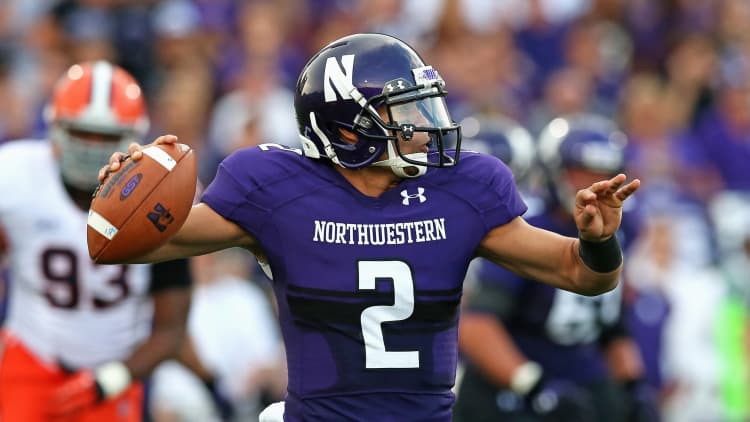This past week may have finally marked the end of college athletes as amateurs, say experts.
It was on Friday that a district court judge in California ruled in favor of former UCLA basketball star Ed O'Bannon, who sued the NCAA over compensation for the use of university player names and likenesses.
And just the day before, the NCAA—college sports' governing body—announced it would allow more freedom to schools and athletes on how they run their sports programs. That's likely to result in player stipends and increased financial aid.
Read MoreHow the NCAA rich will stay richer: Two-tier economy
Both decisions break down the current economic stranglehold on student athletics, said Mark Conrad, professor of sports business at Fordham University.
"The judge in the O'Bannon case relaxed the NCAA mandates to create the possibilities of limited compensation schemes based on earnings for use of likenesses and names," he explained.
"And the NCAA rule change makes it possible for student-athletes to receive compensation if the respective conference wishes," Conrad added.
In fact, said sports attorney Exavier Pope, the NCAA's announcement on Thursday may have come about because the organization knew it could lose the O'Bannon case, which it vowed to appeal.
"They (NCAA) had to know the ruling wasn't going in their favor," he said. "Their vote to change the rules could have been anticipatory."
But the O'Bannon case wasn't a total victory for athletes, said Pat Rishe, professor of sports economics at Webster University.
"The NCAA won a small point as the judge capped the potential payments to select athletes at $5,000 annually, and that would be deferred until a student left the institution," he said.
Also, the ruling does not allow for any compensation for actually playing, said sports lawyer Pope. What it does do is allow college players to benefit from the intellectual property associated with their personal brand on video games, rebroadcasting of college games on TV and merchandising products.
Read MoreInside MLS expansion: Q&A with a sports economist
However, where the O'Bannon case never called for college athletes to get paid for playing, the NCAA rule change just might, say experts. That's because of who's setting the rules. The new structure is geared toward the five biggest revenue-producing sports conferences in Division I. They are the ACC, Big Ten, Big 12, Pac-12 and the SEC.
Those conferences will be able to decide on issues like player stipends, insurance benefits, team staff sizes, recruiting rules and mandatory hours spent on individual sports.
Any changes will have to be approved by a five-conference board that will consist of college presidents, faculty members, athletic directors, conference commissioners, a female representative and student-athletes. The legislative process is expected to begin Oct. 1 of this year.

The new structure has been in the works for some time, but some smaller colleges and universities fought against it.
That was because as part of the original deal, the larger schools had proposed giving out $3,000 stipends to student-athletes on top of scholarships. Smaller schools said they couldn't afford that.
According to data from the U.S. Department of Education, the five power conferences rake in billions that could allow them to pay more than the $3,000. SEC schools combined to create $1.32 billion in revenue in 2012. In that same year, the Big Ten generated $1.15 billion, the Big 12 $881 million, the Pac-12 $823 million and the ACC had $838 million in revenues.
Read MoreProbe: No sign of criminal intent in Stewart crash
The new setup will not force the smaller schools to follow any rule changes if they don't want to. However, there's still concern the changes will hurt smaller schools, said Webster University's Rishe.
"The smaller conferences in football are still getting the five-star kids, so I don't think there will be any imbalance there," he said. "It's the other sports where I see a problem."
Rishe cited college basketball's Wichita State University, which plays in the smaller Missouri Valley Conference. He said if a school like the Big Ten's Minnesota can offer a stipend and WSU doesn't have the money to, a player would probably go to Minnesota—even though it's not a basketball powerhouse. That scenario would possibly be the same in other sports, Rishe said.
'Slippery slope for NCAA'
Even as the NCAA itself loosens its grip on college athletics, it's still fighting over what defines a student-athlete.
On Sunday, the NCAA released a statement saying it would appeal the O'Bannon decision. But that's a risky move, said Fordham's Conrad.
"An appeals court could go farther in deregulating student-athlete compensation," he argued. "It would be better for them to settle this."
Read MoreJohnny Football puts derivatives in playbook
There are more battles ahead. The NCAA, along with Northwestern University, is appealing a regional NLRB ruling this summer that classified the school's football players as employees of the university who have the right to unionize.
Plus, the NCAA faces a lawsuit that could in essence turn college sports into a free market. That suit, filed by sports attorney Jeffery Kessler last March, seeks to overturn the NCAA's economic model and allow college athletes to be paid beyond their scholarships.
"It's a slippery slope for the NCAA," said sports attorney Pope.
—By CNBC's Mark Koba


